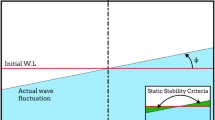Abstract
In the present study a novel modeling approach is presented to solve the combined internal sloshing and sea-keeping problem. The model deals with interesting effects arising due to the coupled interaction between the sloshing in partially filled containers of several geometries and the ship motion. The study is very important for the liquid cargo carrier operating in rough sea or under different environmental conditions. The resulting slosh characteristics that include transient pressure variation, free surface profiles and hydrodynamic pressure over the container walls have been reported in this study. In addition, the effects of coupled ship response and sloshing on ship motion parameters have also been investigated. The equations of motion of fluid, considered inviscid, irrotational, and partially compressible, are expressed in terms of the pressure variable alone. A finite difference-based iterative time-stepping technique is employed to advance the coupled solution in the time domain. Several parameters of interest, including the container parameters, level of liquid, thrusters modeling and some important environmental factors are investigated.













Similar content being viewed by others
References
Kim Y, Nam BW, Kim DW, Kim YS (2007) Study on coupling effects of ship motion and sloshing. Ocean Eng 34(16):2176–2187
Lee DY, Choi HS (1999) Study on sloshing in cargo tanks including hydroelastic effects. J Mar Sci Technol 4:27–34
Kim Y (2002) A numerical study on sloshing flows coupled with the ship motion; anti-rolling tank problem. J Ship Res 46(1):52–62
Molin B, Remy F, Rigaud S, De Jouette Ch (2002) LNG-FPSO’s: frequency domain, coupled analysis of support and liquid cargo motion. In: Proceedings of the IMAM conference, Rethymnon, Greece
Malenica S, Zalar M, Chen XB (2003) Dynamic coupling of seakeeping and sloshing. In: Proceedings of the 13th international offshore and polar engineering conference, vol 3, Hawaii, USA, pp 484–490
Kim JW, Sim IH, Shin Y, Kim YS, Bai KJ (2003) A three-dimensional finite element computation for the sloshing impact pressure in LNG tank. In: Proceedings of 13th ISOPE, Honolulu
Rognebakke OF, Faltinsen OM (2003) Coupling of sloshing and ship motions. J Ship Res 47(3):208–221
Zhang A, Suzuki K (2007) A comparative study of numerical simulations for fluid–structure interaction of liquid-filled tank during ship collision. Ocean Eng 34:645–652
Lee DH, Kim MH, Kwon SH, Kim JW, Lee YB (2007) A parametric sensitivity study on LNG tank sloshing loads by numerical simulations. Ocean Eng 34:3–9
Lee SJ, Kim MH, Lee DH, Kim JW, Kim YH (2007) The effects of LNG tank sloshing on the global motions of LNG carriers. Ocean Eng 34:10–20
Huang ZJ, Esenkov OE, O’Donnell BJ, Yung TW (2009) Coupled tank sloshing and LNG carrier, motions ExxonMobil upstream research. In: Martin CB (ed) Sloshing dynamics symposium, ISOPE 2009
Lee Y, Godderidge B, Temarel P, Tan M, Turnock SR (2009) Coupling between ship motion and sloshing using potential flow analysis compared to equivalent pendulum system sloshing dynamics symposium, ISOPE 2009
Zalar M, Diebold L, Baudin E, Henry J, Chen XB (2007) Sloshing effects accounting for dynamic coupling between vessel and tank liquid motion. In: 26th international conference on offshore mechanics and arctic engineering, June 10–15, 2007, San Diego, California, USA, Paper No. OMAE2007-29544, pp 687–701
Nasar T, Sannasiraj SA, Sundar V (2010) Motion responses of barge carrying liquid tank. Ocean Eng 37:935–946
Bass RL, Bowles EB Jr, Trudell RW, Navickas J, Peck JC, Yoshimura N, Endo S, Pots BFM (1985) Modeling criteria for scaled LNG sloshing experiments. J Fluid Eng 107:272–280
Lee DH, Kim MH, Kwon SH, Kim JW, Lee YB (2005) A parametric and numerical study on LNG-tank sloshing loads. In: Proceedings of the 15th international offshore and polar engineering conference, Seoul, Korea
Bathe K-J (1996) Finite element procedures. Prentice-Hall of India Private Limited, New Delhi
Mitra S, Sinhamahapatra KP (2007) Slosh dynamics of liquid filled containers with submerged component using pressure based finite element method. J Sound Vib 304:361–381
Fossen TI (2002) Marine control systems, 2nd edn. Tapir Trykkeri, Trondheim
Balchen JG, Jenssen NA, Mathisen E, Sælid S (1980) A dynamic positioning system based on Kalman filtering and optimal control. Model Identif Control 1(3):135–163
Sørensen AJ (2005) Structural issues in the design and operation of marine control systems. Ann Rev Control 29(1):125–149
Nguyen TD, Sørensen AJ, Quek ST (2007) Design of high level hybrid controller for dynamic positioning from calm to extreme sea conditions. Automatica 43(5):768–785
Koh HM, Kim JK, Park JH (1998) Fluid–structure interaction analysis of 3-D rectangular tanks by a variationally coupled BEM–FEM and comparison with test results. J Earthq Eng Struct Dyn 27:109–124
Hasselmann K et al (1973) Measurements of wind-wave growth and swell decay during the Joint North Sea Wave Project (JONSWAP). Dtsch Hydrogr ZA (8):1–94
Chen JZ, Kianoush MR (2005) Seismic response of concrete rectangular tanks for liquid containing structures. Can J Civil Eng 32:739–752
Hai LV, Ang KK, Wang CM (2007) Coupled interaction problem between liquid sloshing, multi-containers and ship motion. In: Fifth international conference on advances in steel structures ICASS, Singapore, vol 3, pp 639–644
Price WG, Bishop RED (1974) Probabilistic theory of ship dynamics. Chapman and Hall, London
Acknowledgments
The authors greatly acknowledge the Centre for Ships and Ocean Structures (CeSOS) at Norwegian University of Science and Technology (NTNU) for ship motion MCsim β4 program developed by Oyvind Notland Smogeli and students. The first author is grateful for the financial support provided by the Centre for Offshore Research and Engineering (CORE) at the National University of Singapore. This work is partially supported by a grant from Qatar National Research Foundation under NPRP-08-691-2-289.
Author information
Authors and Affiliations
Corresponding author
About this article
Cite this article
Mitra, S., Hai, L.V., Jing, L. et al. A fully coupled ship motion and sloshing analysis in various container geometries. J Mar Sci Technol 17, 139–153 (2012). https://doi.org/10.1007/s00773-012-0157-2
Received:
Accepted:
Published:
Issue Date:
DOI: https://doi.org/10.1007/s00773-012-0157-2




